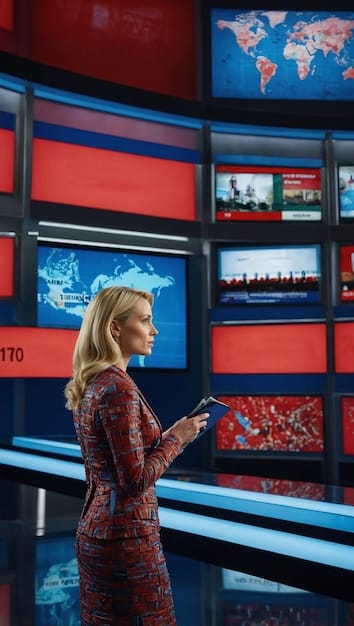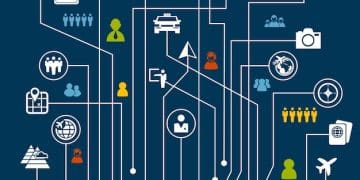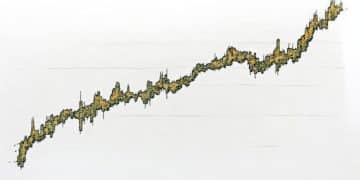Timeless Reports vs. Traditional News: Future Accuracy Showdown

Timeless reports offer enduring insights by focusing on fundamental principles and long-term trends, while traditional news emphasizes immediate events, raising questions about which provides a more accurate view of the future.
In a world saturated with information, discerning reliable insights about the future becomes crucial. The debate of timeless reports vs. traditional news: which provides a more accurate view of the future? is increasingly relevant.
Understanding Timeless Reports
Timeless reports are characterized by their focus on enduring principles, historical analysis, and fundamental trends rather than fleeting events. These reports aim to provide a comprehensive understanding of underlying mechanisms and long-term patterns.
By examining data and insights across extended periods, timeless reports seek to transcend the noise of daily news cycles. This approach offers a perspective that is less influenced by immediate reactions and more oriented toward sustainable, valid knowledge.
Key Characteristics of Timeless Reports
Timeless reports often share several common characteristics that set them apart from traditional news. Identifying these characteristics is essential in understanding their value and utility.
These reports emphasize depth over breadth, employing rigorous research methodologies and interdisciplinary approaches to create lasting insights.
- Long-Term Focus: Analyzing trends and patterns over extended periods.
- Fundamental Principles: Examining the underlying mechanics that drive events.
- Comprehensive Analysis: Integrating insights from multiple disciplines.
- Reduced Sensationalism: Avoiding overemphasis on dramatic or fleeting events.
Unlike news, which aims to inform about recent developments, timeless reports provide a broad perspective rooted in persistent, significant data.
Dissecting Traditional News
Traditional news focuses on current events, delivering information about what is happening in the world, often in real-time. This type of news is critical for staying updated on immediate developments and breaking stories.
While traditional news plays an important role in keeping the public informed, its emphasis on recency can sometimes overshadow in-depth analysis and historical context. The rapid pace of news cycles can also lead to a fragmented view of events.

Shortcomings of a Solely News-Driven Perspective
While news is valuable for capturing current happenings, relying exclusively on it to understand the future can be problematic. Key issues often require a deeper, more contextual understanding.
News cycles are inherently fleeting, and can sometimes provide a distorted picture of ongoing trends. The emphasis on immediacy can lead to a lack of nuanced analysis.
- Lack of context: News often presents events without adequate background.
- Short-term focus: The urgency of news can sideline long-term implications.
- Potential for bias: News reporting can be influenced by opinion and perspective.
- Distorted Reality: Overemphasis on sensational or unusual stories.
For individuals seeking a more profound understanding of the past, present, and potential future, it is vital to complement news consumption with broader, more timeless sources.
The Accuracy Question: Which Provides Better Insights?
The quest for accuracy often drives the choice between timeless reports and traditional news. Deciding which offers better insights requires careful consideration of the specific goals.
While traditional news excels in delivering timely updates, timeless reports offer a depth of analysis that is vital for long-term strategic planning. Each serves a distinct purpose in understanding the world.
Advantages of Timeless Reports in Predictive Analysis
Timeless reports offer several advantages in predictive analysis, largely due to their historical perspective and rigorous methodologies.
These reports use quantitative and qualitative data to uncover meaningful patterns and trends. They provide a foundation for making informed predictions that are more reliable than relying solely on current news.
- Deeper Understanding: Comprehensive analysis beyond immediate events.
- Historical Perspective: Insights derived from long-term data patterns.
- Data-Driven Predictions: Quantitative and qualitative foundations.
- Reduced Bias Impact: Greater emphasis on facts and underlying drivers.
By examining systemic causes and overarching trends, timeless reports provide a predictive framework that is less susceptible to the distortions of immediate news cycles.
Real-World Examples: Comparing Apples and Oranges?
Examining real-world examples can help illustrate the differences between approaches that rely on traditional news vs. timeless reports. These examples clarify how each can shape our understanding of events.
Consider the analysis of economic trends. News cycles might highlight the fluctuations in the stock market, whereas timeless reports could delve into the underlying factors driving broader economic shifts, such as technological advancement or demographic changes.

Case Studies Illustrating Contrasting Perspectives
Several case studies highlight the advantages of integrating both traditional news and timeless analysis. These cases emphasize how a blend of both disciplines provides a fuller understanding.
During a health crisis, news reports on infection rates are useful for immediate responses, but timeless analysis of public health policy provides a deeper understanding of systemic issues and long-term strategies.
- Climate Change: News reports on individual weather events versus long term trend analysis.
- Political Instability: Coverage of daily protests versus historical analysis of political structures.
- Technological Disruption: News on the release of new gadgets versus analysis on the broader future.
- Market Volatility: Daily stock fluctuations versus long-term investment strategy reports.
In each scenario, integrating the immediacy of news with the profundity of timeless reports provides the best possible insight.
The E-E-A-T Framework: Experience, Expertise, Authoritativeness, Trustworthiness
Experience, Expertise, Authoritativeness, and Trustworthiness (E-E-A-T) are critical components of high-quality, reliable content. Applying the E-E-A-T framework to both timeless reports and traditional news helps gauge their credibility.
This framework provides a guidepost for evaluating the rigor, accuracy, and reliability of the information conveyed. Understanding how these components apply in both contexts is essential.
Applying E-E-A-T in Evaluating News and Reports
To effectively assess both news and timeless reports, one must consider how each element of E-E-A-T is demonstrated in the content.
Evaluate the sources, methodologies, and track records to determine the reliability of the information. This ensures an informed assessment.
- Experience: Look for first hand accounts, real-world examples, and practical insights.
- Expertise: Assess the qualifications and knowledge demonstrated by the source.
- Authoritativeness: Verify the source’s reputation and recognition within its field.
- Trustworthiness: Confirm accuracy, transparency, and lack of bias.
Applying these principles will enhance the consumer’s ability to evaluate information and prevent misuse.
Future Gazing: Integrating Both for a Comprehensive View
Ultimately, understanding the future requires integrating both timeless reports and traditional news. Neither alone provides a complete picture; combine them.
The blend of both sources leads to a more nuanced, informed perspective. This integration allows individuals and organizations, to make far more sound decisions.
The Power of Cumulative Knowledge
The cumulative impact of integrating these information sources enables a deeper, more strategic understanding of the world.
Strategic individuals utilize the immediacy of news to maintain awareness, while leveraging the depth of timeless reports to inform long-term decision-making.
- Informed Decision Making: Leverage both types of sources for a rounded view.
- Strategic Planning: Use timeless reports to develop long-term strategies.
- Dynamic Adaptation: Evolving both to adapt to change.
- Greater Resilience: Anticipating and preparing for various types of changes.
In a complex landscape, combining different types of insights maximizes reliability.
| Key Point | Brief Description |
|---|---|
| ⏳ Timeless Reports | Focus on long-term trends, fundamental principles, and historical data. |
| 📰 Traditional News | Emphasizes immediate events, breaking stories, and the latest updates. |
| 📊 Predictive Accuracy | Timeless reports offer more predictive accuracy by examining systemic causes and patterns. |
| 🤝 Integration | Combining both provides a comprehensive understanding for effective decision-making. |
Frequently Asked Questions
▼
Timeless reports focus on enduring principles and long-term trends, providing deeper insights that transcend short-term news cycles. They examine historical data and fundamental mechanisms to forecast future trends.
▼
These reports dig deep into underlying factors and systemic causes, reducing the impact of immediate fluctuations. By revealing persistent patterns, analysts can make informed predictions less susceptible to short-term noise.
▼
Traditional news provides immediate information about current events, which is essential for staying updated. However, it should be balanced with deeper analysis to avoid a fragmented and potentially distorted long range scenario.
▼
E-E-A-T (Experience, Expertise, Authoritativeness, Trustworthiness) provides a structured approach to assess source credibility. By examining qualifications, reputation, and factual accuracy, you can better assess reliability.
▼
Integrating both offers a comprehensive perspective. Immediacy derived from news will keep you updated, where timeliness can be used for long-term planning and strategic choices. This combination supports better decisions and overall preparedness.
Conclusion
In conclusion, while traditional news delivers immediate updates, timeless reports provide enduring insights grounded in historical analysis and fundamental principles. Integrating both creates a comprehensive understanding that empowers individuals and organizations to make informed decisions about the future, and adapt with greater resilience.





